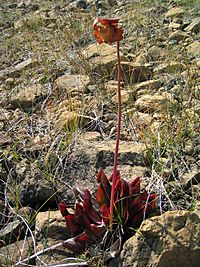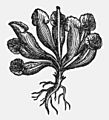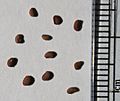Sarracenia purpurea facts for kids
Sarracenia purpurea is a very special type of carnivorous plant. It's often called the purple pitcher plant because of its unique, pitcher-shaped leaves that look like colorful cups. People also call it the northern pitcher plant, turtle socks, or side-saddle flower. This amazing plant catches and eats insects!
Contents
What is a Carnivorous Plant?
A carnivorous plant is a plant that gets some of its nutrients by trapping and eating small animals, usually insects. These plants often grow in places where the soil is poor and doesn't have many nutrients, like nitrogen. So, they have developed clever ways to get what they need from bugs!
How the Purple Pitcher Plant Catches Food
The purple pitcher plant has leaves that are shaped like pitchers or cups. These pitchers are usually reddish-purple and can hold rainwater. Inside the pitcher, there are tiny hairs that point downwards. This makes it hard for insects to crawl back out once they fall in.
The Pitcher's Traps
The rim of the pitcher often has a sweet nectar that attracts insects. When an insect lands on the slippery edge, it can easily fall into the water inside. The water contains special enzymes that help the plant digest the insect. It's like a natural stomach for bugs!
What it Eats
The purple pitcher plant mostly eats insects like ants, flies, and beetles. Sometimes, even larger insects or spiders can get trapped. The plant then absorbs the nutrients from the digested insects, which helps it grow strong and healthy.
Where the Purple Pitcher Plant Lives
This plant is found in cool, wet, and sunny places across North America. It grows in bogs, fens, and wet meadows. These areas have very acidic soil that is low in nutrients, which is why the plant needs to catch insects.
Its Habitat
You can find the purple pitcher plant from Canada all the way down to the southeastern United States. It loves open, sunny spots where there's plenty of moisture. It's a very hardy plant and can even survive cold winters.
Life Cycle and Reproduction
The purple pitcher plant is a perennial, meaning it lives for many years. It grows from a rhizome, which is an underground stem. Each spring, new pitcher leaves grow from the rhizome.
Flowers and Seeds
In late spring or early summer, the purple pitcher plant produces a single, nodding flower on a tall stalk. The flower is usually reddish-purple, just like its leaves. After the flower is pollinated, it produces many small seeds. These seeds are then dispersed by wind or water, helping new plants grow in other areas.
Surviving Winter
During the colder months, the plant's leaves might turn brown, but the rhizome stays alive underground. It can even survive being frozen solid! When spring arrives, new growth emerges from the rhizome, and the cycle begins again.
Images for kids
See also
 In Spanish: Planta jarra púrpura para niños
In Spanish: Planta jarra púrpura para niños





